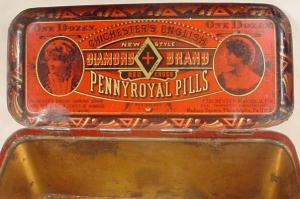Maws & Bairns: Maternal & Child Health in Tayside
Care and Prevention
Family Planning
For thousands of years women have inserted fruit acids, jellies, pastes and various mixtures into their vagina in an attempt to prevent conception. Environments that are either sharply acidic or alkaline are hostile to sperm, and therefore these methods may have had some effect. Today, there is only one spermicidal gel available in the UK.
In the 18th century, condoms were made from animal intestines, but these gave way to rubber in the 1840s, and latex in the 1930s. Polyurethane arrived in 1997.
The invention of the diaphragm in 1882 contributed to the emancipation of women, allowing them to control their own fertility for the first time. The first intrauterine device (a ring of silk-worm gut) appeared in 1909, and those made of plastic and copper were developed in the 1960s.
Oral contraceptives date back 2000 years, early preparations varying from eating willow shoots and bees to consuming the internal scrapings of male deer horns. The development of early modern contraceptive pills in the 1950s followed from the discovery that the roots of the wild yam contained diosgenin, which could be converted in the laboratory to progesterone. In 1960, the first large-scale British clinical trials of oral contraceptives were carried out, and the following year Conovid, Conovid E and Anovlar which contained high doses of oestrogen and progestogen were approved for use in Great Britain. Each pill used in the 1960s was roughly equivalent to seven of today’s pills.
 The photo on the left shows that Pennyroyal pills were used in the late 19th and early 20th centuries to treat amenorrhea, but also (unofficially) to terminate unwanted pregnancy.
The photo on the left shows that Pennyroyal pills were used in the late 19th and early 20th centuries to treat amenorrhea, but also (unofficially) to terminate unwanted pregnancy.
In 1921, the first UK birth control clinic was founded in London by Marie Stopes. The National Birth Control Association was formed ten years later, becoming the Family Planning Association in 1939.
The first Family Planning Clinic (FPC) in Dundee started in 1955, although it was to be another 10 years before it was agreed to see ‘premaritals’, and only then up to three months before the wedding. Perth had been running FPCs since 1949, but even in the late 1960s intrauterine contraceptive devices could only be inserted with the husband’s written consent. Angus was apparently hostile to FPCs, an attempt to set one up in Arbroath in 1968 having to be dropped as “the new Medical Officer of Health did not fully approve of family planning”. However, in 1974 FPCs were absorbed into the National Health Service, and a free service was provided to anyone who wanted it.
Breast-feeding
A century ago, the Dundee Social Union laid great emphasis on the importance of breastfeeding of infants for the first 3 months of life. Although the Scottish Government’s target is to increase exclusive breastfeeding at the first 6-8 week review, sadly this has remained static over the past decade at around 26%, and in Dundee as low as 15.7%.
A series of papers from the Dundee Infant Feeding Study in the 1990s showed an association between exclusive breast feeding for 3-4 months and a reduction in infections during infancy, reduced respiratory illness in childhood and lower blood pressure at age 7 years. Currently the World Health Organisation promotes exclusive breast feeding for at least 6 months, although many feel that 4 months is a more appropriate figure to aim for in developed countries.
Neonatal Intensive Care
In the early 1950s, in no centre in Scotland did the professors of obstetrics and paediatrics (who dominated clinical practice in the teaching hospitals) share a primary interest in the newborn. It was only when the new Chair of Obstetrics in Dundee James Walker teamed up with the Professor of Child Health John Henderson in 1956 that the change began with the creation of a 20-bed purpose-built special care baby unit in 1959, the first in Scotland, and regarded as one of the best in Britain in the 1960s.
Later, while on a fact-finding mission in America, Professor Henderson recruited Dr Colin Walker, an Edinburgh graduate, to take up the post of neonatal paediatrician after Ross Mitchell moved temporarily to Aberdeen. In 1964, the first baby in Scotland (second in the UK) to be treated with artificial ventilation took place in Dundee, using a ventilator brought by Dr Walker on the plane home!
Great strides have subsequently been made in the care of the newborn. When Ninewells opened in 1974, the youngest baby admitted to the neonatal unit was around 28 weeks, but with development of surfactant and antenatal steroids to make the lungs more mature and compliant, better humidity and fluid balance control, the use of CPAP rather than ventilation and nitrous oxide to reduce pulmonary pressure, babies of 23 weeks are now a viable proposition.
Image courtesy of Private Collection